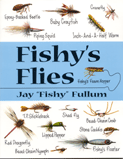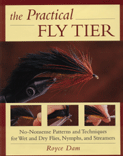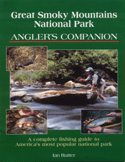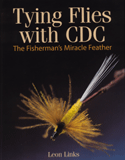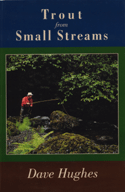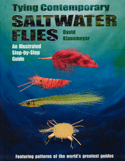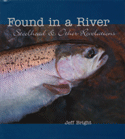 |
||
|
Premier Fly Fishing Services |
||
|
Fly fishing and fly tying books are a passion. Here you will find book reviews of books I have read covering fly fishing for trout, smallmouth bass, muskellunge, steelhead, and many other freshwater and saltwater species. You will also find fly tying books covering the same areas. There are also books on aquatic entomology, history of fly fishing and fly tying, hydrology, and great prose having fly fishing as its main theme. There is far more to fly fishing than casting a line, and there should be far more to a fly fishing guide service web site than just costs and services offered.
Fishy’s Flies reviewed by Bruce E. Harang This is one of the best surprises the year for the fly tier. A small volume in size but a gigantic volume in fun and novel fly tying techniques and materials. In only 68 pages of text and wonderfully clear line drawings the author teaches how to tie twenty-seven different fly patterns he has created. Here you will find foam hoppers, epoxy ants, craneflies, stickleback minnows, and stoneflies tied with plastic canvas, lipped poppers, and bead-chain crabs. Each and everyone tied using novel materials found in out of the way places and products designed for all manner of uses other than fly tying. But don’t let the fun and novelty fool you. These flies are both very fishable and very durable. If you are a natural materials traditionalist you may have a bit of a psychological barrier to overcome. After all using an electric pencil sharpener on a bit of balsa wood to make a popper body, or to cut a piece of needlepoint plastic canvas to create a stonefly takes just a bit of loosening up mentally. The warm-water and saltwater tiers will not have this problem to the same extent as they are used to using all manner of synthetic material in their everyday fly tying.. Once over this hurdle however, the reader will be surprised on how much fun and how effective flies designed by the author can be. Overall this slim volume provides the fly tier with interesting, fun, and effective materials and techniques for tying a larger variety of effective fishing flies. With a retail price of under $10.00 the reader receives his moneys worth and much more. For innovative and inquisitive fly tiers this book is a must. © 2002 Bruce E. Harang
The Practical Fly Tier reviewed by Bruce E. Harang Royce Dam is one of the finest fly tiers I have had the privilege to watch and to chat with. He is also one of the nicest people you will ever meet, as well as an effective teacher. Royce’s use of carded wool for fly bodies is extremely effective. It is also very easy to learn. If this was all that was taught in this book it would be more than worth its purchase price. Fortunately, for all of us that tie flies, Royce didn’t stop with a discussion of making and using carded wool for fly tying. Instead he has produced a book chuck full of useful practical fly tying techniques. You will not find a finer volume of practical fly tying methods allowing you, the fly tier, to produce beautiful, functional, and effective flies. Every technique is clearly explained in easy steps. Each step is illustrated by high quality photo images by Thom Beck. Thom clearly understands microphotography as well as Royce understands fly tying. The photos are all well exposed, well focused, and make the procedure in question the center point of each photograph. The only point I would have liked to have seen in the photos would be to have removed the support from some of the fly shots as they tend to distract a bit from the flies themselves. Royce provides comprehensive chapters on tying wet flies, dry flies, nymphs, and streamers. In each section he also starts each section with clear concise descriptions of tying techniques needed to be successful tying these flies. Along with the opening chapter on tools the reader has an extremely useful learning program. This reader was pleasantly surprised at the amount of good information the author has packed into only five chapters. The overall layout, design and editing are of the highest quality. Mark Van Patten and Art Scheck desire recognition for doing such good work in this area. Most readers never consciously look at these areas of a book. However, most readers instinctively know when a book seems easy, or hard, to read. The difference between the two types of books is the quality of the layout and editing. Royce’s book is a prime example of a book that is easy to read. If you tie flies at any level this book is a must addition to your library. © 2002 Bruce E. Harang
Great Smoky
Mountains National Park reviewed by Bruce E. Harang
If you
would like a good starting point for fishing in the nation’s most popular
national park this book is the one to read. Ian Rutter guided in the Park
for a number of years and has first hand knowledge of the streams he
describes. The book is divided into two major sections; fishing in the Park
and stream descriptions. The first section on fishing in the Park is broken
down into sections on the streams, the fish, the fishing seasons, the
fishing methods and the flies as well as a short introduction describing the
symbols used throughout the book. The second section breaks the Park down
around five base areas and describes in greater detail the streams in each
of these areas as well as how to access them and what to use once you get
there. © 2003 Bruce E. Harang
Tying Flies with CDC reviewed by Bruce E. Harang
The
feathers around the preen gland of waterfowl have a structure like no other
feather. Called Cul de Canard by some and CDC by others, this feather has a
remarkable ability to entice fish to take a fly upon which it is tied. Up
until now however, accurate information on the history, origin, and patterns
utilizing this wonderful fly tying material have been very hard to come by.
With this book the author has provided a first major step in correcting this
situation. The author traces the history of the use of CDC in flies. Where
the use of the material started, how it is used, and backgrounds of many of
the people who have been instrumental in using and fishing flies
incorporating CDC feathers. © 2003 Bruce E. Harang
Trout from Small Streams reviewed by Bruce E. Harang
Dave
Hughes has once again produced an outstanding fly fishing book. It is also
very refreshing in format as it is a text only layout without the now
popular and over exploited photograph or drawing for every thought. Once
again Dave Hughes work has reminded me in a most favorable way of the
writing style, and intellectual level, of G. E. M. Skues. © 2003 Bruce E. Harang
Tying Contemporary reviewed by Bruce E. Harang
David
Klausmeyer is a name familiar to most fly tyers. His books on tying are
considered by many to be some of the best ever done. This book is no
exception. For the fly tyer that wants to learn to tie saltwater flies
popular today this book is a dream come true.
© 2003 Bruce E. Harang
Found in a River reviewed by Bruce E. Harang
This small volume is a
wonderful interlude of peace in a busy world by a man who has refused to
loose the wide eyed wonder of childhood. A collection of poems vividly
describing the ephemeral qualities of the Steelhead Rainbow Trout
accompanied by photographic images that evoke a dreamlike vision of being on
a river with them. The author brings to reality the emotional soul of why
some of us cast a fly, in the worst weather, for a fish seldom caught in
large numbers. Like a sailor always believing a mermaid is possible, so to
the steelheader believes that a steelhead on the end of the line is just as
possible. © 2003 Bruce E. Harang
Mayflies "Top to Bottom" reviewed by Bruce E. Harang
The author
is one of the first US tiers
to publicize the use of CDC feathers for fly tying. His innovative patterns
and tying methods have become a standard for CDC patterns in the US and now
in many other countries as well. © 2003 Bruce E. Harang
|
||
|
|
Phone: 360-903-4693 |
|
